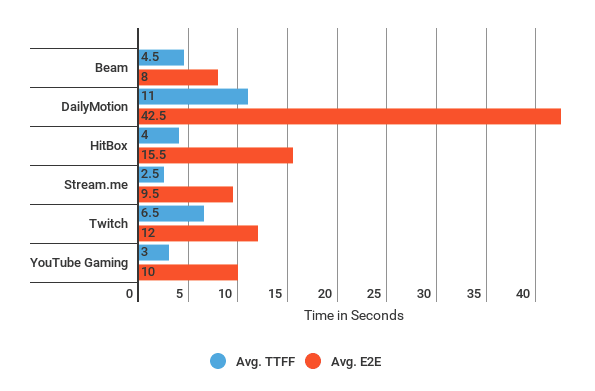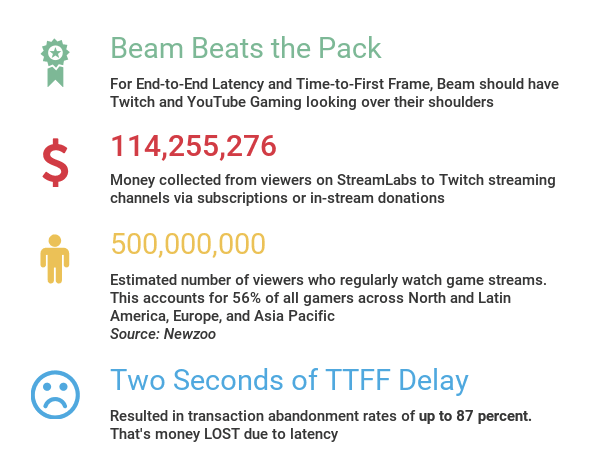Game streaming services have become hugely popular in recent years. These platforms allow streamers to broadcast themselves playing; viewers tune in to watch the stream, and to interact with the gamers as well as each other. Streamers even form communities of users who regularly watch their channels. Engagement is naturally high on these platforms--unlike many other markets, it's common for users to spend three hours in a given session. The biggest draw of game streaming services is this opportunity to interact with other streamers and viewers. All the major platforms feature a large window for viewing gameplay; picture-in-picture video of the streamer playing; and a chat window where all participants can interact. Viewers offer tips and suggestions to the streamer--for example, how to navigate a level or defeat an enemy--and talk to each other about the game, or simply about life. What's more, game streaming services are a perfect example of how the power in consumer markets has shifted from the supplier to the customer. While game trailers used to be the primary method by which customers decided if they wanted to buy a game, now they can watch someone else play the entire game from start to finish before making a purchase decision. In an interview, Stu Grubbs, CEO of Infiniscene, an emerging game streaming service that delivers to Twitch, Beam, Hitbox and other platforms, noted the impact of latency to the viewer and broadcaster experience. He stated: "The success of video game live streaming depends on authenticity. In most cases, the ability to interact with the audiences, while sharing their gameplay experience not only increases the authenticity of the broadcaster, but the viewer experience. As you increase stream's latency, the lack of interactivity or ability to engage in near real-time immediately impacts the viewer's perception of the game or quality of the streamer's content. That's why latency is critical for game streamers." Since interactivity and real-time video are cornerstones of the user experience for game streaming platforms, low latency is especially important. To see how successfully this is being achieved, we tested the latency of six well-known game streaming services with publicly available platforms: Beam, DailyMotion, HitBox, Stream.me, Twitch, YouTube Gaming. Here are the results:  Beam.pro: Maximum Interactivity, Lowest Latency The winner in our latency test is a startup that was recently acquired by Microsoft: Beam.pro. It tested as low as four seconds and as high as 10 seconds in end-to-end latency. TTFF clocked in at three to six seconds. Like the other platforms we tested, Beam offers live-streaming gameplay with a real-time chat window for viewer and gamer interaction. However, Beam takes the interactive element a step further--it allows viewers to actually interact with the streamer's gameplay in real time. Viewers can control key elements of the game itself, by creating bosses for the player to fight, giving them extra health, changing the surroundings, swapping out weapons and more. Watching someone else play a game--especially if it's one you've already played--is an inherently passive activity. For that reason, the degree of interactivity offered is a key differentiator for Beam. Along with access to high-quality, uninterrupted gameplay streams, this allows the platform to provide a unique, high-quality user experience. "Massive communities are formed around games, and live streams provide a central place for those communities to come together and experience the game from another perspective," says Beam CEO Matt Salsamendi. Unlike live sports events, Salsamendi explains, most viewers on game streaming platforms are regular players themselves. While your average sports fan wouldn't tell a star quarterback how to pass, your average gamer has a wealth of tips and suggestions for the streamer--and is eager to participate. That's what differentiates Beam--it actually gives viewers some control over the action. This unique element is developer-supported. As Salsamendi describes, Beam offers a software development kit (SDK) that can be used to turn any game into an interactive experience with "less than 25 lines of code." The company has also developed its proprietary "Faster-than-Light" (FTL) video protocol, which when used exclusively, can provide even lower latency results. The SDK is used to populate buttons under the gameplay screen, which viewers can push to interact with the streamer's game--for example, "Give Health" or "Change Weapon." Added gamification elements include upgrades and enhanced interaction abilities that can be earned by chatting with users and controlling gameplay.
Beam.pro: Maximum Interactivity, Lowest Latency The winner in our latency test is a startup that was recently acquired by Microsoft: Beam.pro. It tested as low as four seconds and as high as 10 seconds in end-to-end latency. TTFF clocked in at three to six seconds. Like the other platforms we tested, Beam offers live-streaming gameplay with a real-time chat window for viewer and gamer interaction. However, Beam takes the interactive element a step further--it allows viewers to actually interact with the streamer's gameplay in real time. Viewers can control key elements of the game itself, by creating bosses for the player to fight, giving them extra health, changing the surroundings, swapping out weapons and more. Watching someone else play a game--especially if it's one you've already played--is an inherently passive activity. For that reason, the degree of interactivity offered is a key differentiator for Beam. Along with access to high-quality, uninterrupted gameplay streams, this allows the platform to provide a unique, high-quality user experience. "Massive communities are formed around games, and live streams provide a central place for those communities to come together and experience the game from another perspective," says Beam CEO Matt Salsamendi. Unlike live sports events, Salsamendi explains, most viewers on game streaming platforms are regular players themselves. While your average sports fan wouldn't tell a star quarterback how to pass, your average gamer has a wealth of tips and suggestions for the streamer--and is eager to participate. That's what differentiates Beam--it actually gives viewers some control over the action. This unique element is developer-supported. As Salsamendi describes, Beam offers a software development kit (SDK) that can be used to turn any game into an interactive experience with "less than 25 lines of code." The company has also developed its proprietary "Faster-than-Light" (FTL) video protocol, which when used exclusively, can provide even lower latency results. The SDK is used to populate buttons under the gameplay screen, which viewers can push to interact with the streamer's game--for example, "Give Health" or "Change Weapon." Added gamification elements include upgrades and enhanced interaction abilities that can be earned by chatting with users and controlling gameplay.  Many users in gaming forums compare Beam with the original game streaming service, Twitch. Both platforms started small, and are now owned by tech behemoths Microsoft (Beam) and Amazon (Twitch). Based on revenue, Twitch has the highest market share of any gaming platform worldwide (43 percent). While Twitch is still seen by many as the industry leader, it may want to start looking over its shoulder. Beam is an innovative disruptor that is winning the latency battle--it even won TechCrunch Disrupt NY in 2016. Game-Streaming UX Relies on Low Latency
Many users in gaming forums compare Beam with the original game streaming service, Twitch. Both platforms started small, and are now owned by tech behemoths Microsoft (Beam) and Amazon (Twitch). Based on revenue, Twitch has the highest market share of any gaming platform worldwide (43 percent). While Twitch is still seen by many as the industry leader, it may want to start looking over its shoulder. Beam is an innovative disruptor that is winning the latency battle--it even won TechCrunch Disrupt NY in 2016. Game-Streaming UX Relies on Low Latency  Of course, all of this interactivity wouldn't be possible without very low latency. If there's a 10-second delay or longer between the streamer completing an action and the viewers seeing it on the screen, by the time they react, it will already be too late. Without a user experience that's as close to real time as possible, the ability to control the game is lost. Low latency is crucial for all game streaming platforms, not just Beam. Any time a gamer is holding a live broadcast, real-time streaming is necessary for a high-quality user experience. If latency is high, streamers will lose viewership--causing revenue losses for both the streamers and the platforms themselves. Streamers make money (and may even make a living) off paid viewer subscriptions. Viewers can also give monetary tips to their favorite gamers. Some platforms, such as Beam and YouTube Gaming, offer extra incentives to streamers when viewers watch without ad-blocking. Fewer subscriptions means less money in the streamer's pocket--and fewer percentages of subscriptions, tips and ad revenue for the platform. Indeed, delays of mere milliseconds can result in lost customers. Even two seconds of latency when loading a gaming transaction can cause abandonment rates of up to 87 percent. First-person shooter games suffer from just 100 milliseconds of latency, since action happens so quickly. Role-playing or turn-based games can afford slightly longer delays, but interactive capabilities may still be impacted. And latency is only becoming more important in this market. Studies show the number of streamers and viewers is steadily increasing, as is the average amount of monetary tips from viewers to streamers (not counting streamers who have partnerships with gaming companies). While monetization data has only been gathered for Twitch, the gaming industry as a whole is growing, predicted at a rate of almost 5 percent per year through the year 2020--so these trends are likely to hold across platforms. As the number of viewers grows, streamers will want increased opportunities to interact with them. The closer to real time these interactions are, the more likely those viewers will support streamers with tips and subscriptions. If Twitch wants to retain its status as a market leader, it must focus on decreasing latency. In game streaming, time is money--and both streamers and viewers are likely to abandon slower platforms for faster, more collaborative entrants such as Beam. Big Market Share, Higher Latency
Of course, all of this interactivity wouldn't be possible without very low latency. If there's a 10-second delay or longer between the streamer completing an action and the viewers seeing it on the screen, by the time they react, it will already be too late. Without a user experience that's as close to real time as possible, the ability to control the game is lost. Low latency is crucial for all game streaming platforms, not just Beam. Any time a gamer is holding a live broadcast, real-time streaming is necessary for a high-quality user experience. If latency is high, streamers will lose viewership--causing revenue losses for both the streamers and the platforms themselves. Streamers make money (and may even make a living) off paid viewer subscriptions. Viewers can also give monetary tips to their favorite gamers. Some platforms, such as Beam and YouTube Gaming, offer extra incentives to streamers when viewers watch without ad-blocking. Fewer subscriptions means less money in the streamer's pocket--and fewer percentages of subscriptions, tips and ad revenue for the platform. Indeed, delays of mere milliseconds can result in lost customers. Even two seconds of latency when loading a gaming transaction can cause abandonment rates of up to 87 percent. First-person shooter games suffer from just 100 milliseconds of latency, since action happens so quickly. Role-playing or turn-based games can afford slightly longer delays, but interactive capabilities may still be impacted. And latency is only becoming more important in this market. Studies show the number of streamers and viewers is steadily increasing, as is the average amount of monetary tips from viewers to streamers (not counting streamers who have partnerships with gaming companies). While monetization data has only been gathered for Twitch, the gaming industry as a whole is growing, predicted at a rate of almost 5 percent per year through the year 2020--so these trends are likely to hold across platforms. As the number of viewers grows, streamers will want increased opportunities to interact with them. The closer to real time these interactions are, the more likely those viewers will support streamers with tips and subscriptions. If Twitch wants to retain its status as a market leader, it must focus on decreasing latency. In game streaming, time is money--and both streamers and viewers are likely to abandon slower platforms for faster, more collaborative entrants such as Beam. Big Market Share, Higher Latency  It should come as no surprise that the leaders and innovators aren't the industry giants. YouTube Gaming and Twitch are the current market leaders in game streaming services. While Twitch has been in the industry longer and has a higher market share by revenue, YouTube Gaming has the largest viewership of any platform--about half of all U.S. game viewers watch on YouTube Gaming, a figure that holds true around the world. To accommodate their massive audiences while maintaining stream quality, these sites have higher latency. YouTube Gaming clocked in at seven to 13 seconds of end-to-end latency; it scored lower in TTFF, at one to five seconds. Twitch scored from 10 to 12 seconds in end-to-end latency, and ranged from five to eight seconds in TTFF. However, many viewers on these platforms watch pre-recorded streams--so a slightly longer end-to-end delay is more acceptable than it is for interactive streams. For pre-recorded video, TTFF is the more important metric, as viewers may skip over slow-loading videos quickly, and may even abandon the platform altogether if they experience too many loading delays. Hitbox and DailyMotion bring up the rear in our latency tests. With their emphasis on eSports, it makes sense that latency is higher for these platforms. For a positive user experience when watching broadcast content, it's more important that the stream is high-quality than that it loads immediately. Since viewers are tuning in to watch a specific event, even 20 seconds or more of latency shouldn't pose a significant problem. It should be noted that eSports is a growing subcategory within the game streaming segment. Both YouTube Gaming and Twitch are beginning to focus more heavily on broadcasting these events--in fact, eSports now makes up 21 percent of viewership on Twitch. The Latency Conclusion Low latency is critical in the game streaming services market. Users come to these platforms to experience live-streaming and pre-recorded gameplay, and to interact with streamers. Streamers too, make their money on paid viewer subscriptions and ad revenue. Games must load quickly, play without buffering and allow viewers to interact in as close as possible to real time in order to maintain viewership. Thus, it is vitally important that gaming platforms provide a high-quality, low-latency video experience for their communities. Beam.pro has the lowest latency of all the platforms we tested. It has also differentiated itself in the market as the only platform that allows viewers to directly interact with the streamer's gameplay in real time. The question remains: when time is money, how will the other platforms make up the gap and continue to innovate? Note: This article was originally published on the Wowza Media Systems blog, and is reproduced here with kind permission from the author. You can reach Wowza Media Systems on Twitter @wowzamedia.
It should come as no surprise that the leaders and innovators aren't the industry giants. YouTube Gaming and Twitch are the current market leaders in game streaming services. While Twitch has been in the industry longer and has a higher market share by revenue, YouTube Gaming has the largest viewership of any platform--about half of all U.S. game viewers watch on YouTube Gaming, a figure that holds true around the world. To accommodate their massive audiences while maintaining stream quality, these sites have higher latency. YouTube Gaming clocked in at seven to 13 seconds of end-to-end latency; it scored lower in TTFF, at one to five seconds. Twitch scored from 10 to 12 seconds in end-to-end latency, and ranged from five to eight seconds in TTFF. However, many viewers on these platforms watch pre-recorded streams--so a slightly longer end-to-end delay is more acceptable than it is for interactive streams. For pre-recorded video, TTFF is the more important metric, as viewers may skip over slow-loading videos quickly, and may even abandon the platform altogether if they experience too many loading delays. Hitbox and DailyMotion bring up the rear in our latency tests. With their emphasis on eSports, it makes sense that latency is higher for these platforms. For a positive user experience when watching broadcast content, it's more important that the stream is high-quality than that it loads immediately. Since viewers are tuning in to watch a specific event, even 20 seconds or more of latency shouldn't pose a significant problem. It should be noted that eSports is a growing subcategory within the game streaming segment. Both YouTube Gaming and Twitch are beginning to focus more heavily on broadcasting these events--in fact, eSports now makes up 21 percent of viewership on Twitch. The Latency Conclusion Low latency is critical in the game streaming services market. Users come to these platforms to experience live-streaming and pre-recorded gameplay, and to interact with streamers. Streamers too, make their money on paid viewer subscriptions and ad revenue. Games must load quickly, play without buffering and allow viewers to interact in as close as possible to real time in order to maintain viewership. Thus, it is vitally important that gaming platforms provide a high-quality, low-latency video experience for their communities. Beam.pro has the lowest latency of all the platforms we tested. It has also differentiated itself in the market as the only platform that allows viewers to directly interact with the streamer's gameplay in real time. The question remains: when time is money, how will the other platforms make up the gap and continue to innovate? Note: This article was originally published on the Wowza Media Systems blog, and is reproduced here with kind permission from the author. You can reach Wowza Media Systems on Twitter @wowzamedia.
Since interactivity and real-time video are cornerstones of the user experience for game streaming platforms, low latency is especially important. To see how successfully this is being achieved, we tested the latency of six well-known game streaming services with publicly available platforms: Beam, DailyMotion, HitBox, Stream.me, Twitch, YouTube Gaming. Here are the results:
Advertisement
Advertisement
Other Tutorials by jbadams
26593 views
8420 views
39912 views
10726 views
12644 views
Advertisement





I assume that 'TTFF' stands for 'time to first frame'? You may want to clearly define that, as it doesn't appear to be in common usage, and Google's best guess was 'time to first fix' in the context of GPS location.
(also, we should clean up the various stray HTML tags in the article)